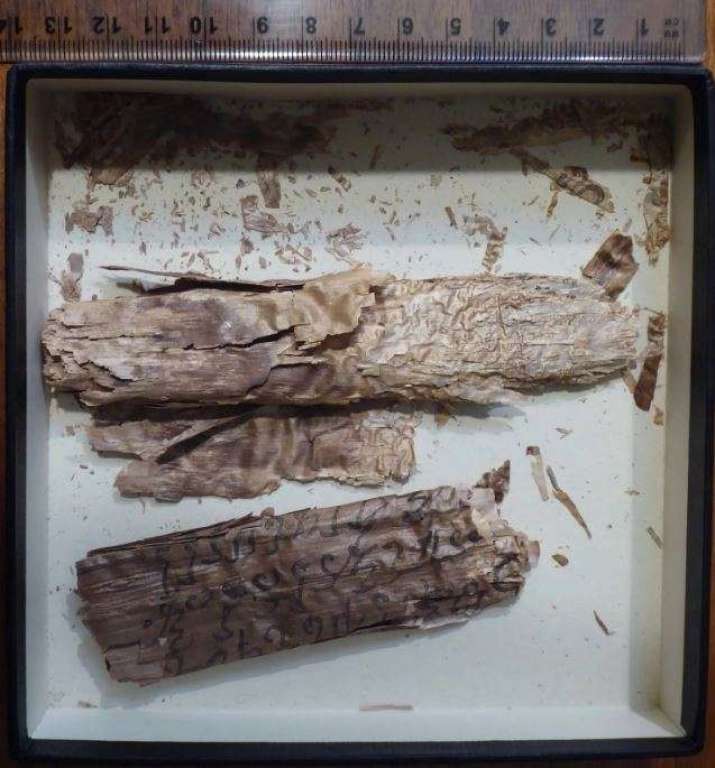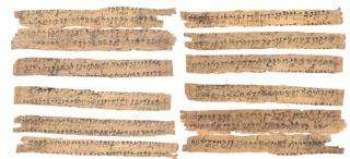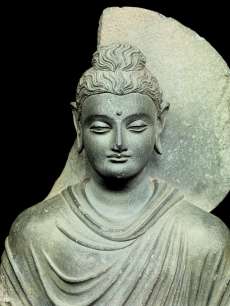Prof. Richard Salomon has been working on Gandhari texts for around 25 years, having assembled a team known as the Early Buddhist Manuscripts Project (EBMP) in conjuction with the British Library in 1996. Their work has focused on 29 fragments of manuscript, written on birch bark scrolls in the Gandhari language—a relative of Pali and Sanskrit—that were found near Jalalabad in eastern Afghanistan. These texts are believed to date to the first century.
NEWS
University of Sydney in Australia Seeks Crowdfunding for Gandhari Buddhist Texts
 Two Gandhari scrolls. From sydney.edu
Two Gandhari scrolls. From sydney.eduDr. Mark Allon, department chair and senior lecturer in South Asian Buddhist Studies at the University of Sydney in Australia, has launched a campaign to fund the restoration and publication of a number of ancient Gandhari Buddhist texts, held to be highly important for understanding the earliest development of Mahayana Buddhism in South Asia. The project aims to raise A$20,000 (US$13,900) by the end of 2019, with the resulting publications to be made freely available to the public.
The project brings together leading researchers from around the world, including Prof. Richard Salomon from the University of Washington, Seattle, Prof. Paul Harrison from Stanford University, and Dr. Andrew Skilton from the University of Oxford, with digital development from Ian McCrabb and Stephanie Majcher also from the University of Sydney.
Discussing the importance of the texts, the crowdfunding page for the project states:
The appearance of these very early witnesses to major Mahayana texts is highly significant. For example, before this the earliest solid witness to the Samadhiraja-sutra was the 5th century AD Chinese translation. The Indian versions are primarily witnessed in much later and more developed Sanskrit manuscripts from Nepal and northern Pakistan. There has been much debate as to whether this text is an early or middle period Mahayana text. This new Gandhari manuscript confirms for the first time that it is early (1st to 2nd century AD) and provides an extremely important witness to a very early stage of its development. Indeed, the study of these texts is a critical element in a re-evaluation of the rise of the Mahayana. (University of Sydney)
 Buddhist manuscripts. From artsci.washington.edu
Buddhist manuscripts. From artsci.washington.eduDescribing the texts, the EBMP project website states: “While some of the texts . . . can be directly identified with, or at least related to, texts extant in other languages, such as Pali, Sanskrit, or Chinese, the majority of them, including many of the avadanas and the commentaries, appear to have no parallels in the previously known Buddhist literatures.” (University of Washington)
“This is not just another text,” Prof. Collete Cox of the Early Buddhist Manuscripts Project told the University of Washington news early in the project. “It is of a completely different order of significance. It’s difficult to describe the magnitude of what we have here. When scholars complete their analysis of this material, it will be revolutionary in how we conceive of early Buddhist monastic life.” (Arts and Sciences News, University of Washington)
 Standing Shakyamuni Buddha, Gandhara Kushan dynasty, second to third century. From ckh.com.hk
Standing Shakyamuni Buddha, Gandhara Kushan dynasty, second to third century. From ckh.com.hkSaloman and others have published widely on the findings from the project, most recently The Buddhist Literature of Ancient Gandhāra: An Introduction with Selected Translations (Wisdom Publications, 2018).
Gandhara, the ancient name for the region where the texts originated, was the seat of several dynasties from the third century BCE to the fourth century CE. Gandhara was at a crossroads of trade, linking India, China, Central Asia, Greece, and other civilizations and peoples. Archaeological evidence, including the famed Bamiyan Buddhas as well as many Greek-influenced statues of the Buddha and Buddhist figures show that Gandhara acted as a vibrant center for Buddhism.
“It only stood to reason that there’d be a literary component of that culture,” said Salomon. “Some of the pieces were in place and now the literary language falls right into place, too.” (Chronicle of Higher Education)
See more
Restoration and publication of Ancient Gandhari Buddhist Texts (University of Sydney)
About The Early Buddhist Manuscripts Project (University of Washington)
Desciphering an Ancient Buddhist Manuscrip (Arts and Sciences News, University of Washington)
A Lost Buddhist Literary Tradition Is Found (Chronicle of Higher Education)
Related news from Buddhistdoor Global
First exhibition of Gandhara Buddhist Antiquities Opens in South Korea
Restoration Workers Tamper with Orginal Buddha Sculptures at Bhamala Buddhist Complex, Pakistan
From Gandhara to Gupta
Is Time Running Out for the 5,000-year-old Mes Aynak Archeological Site in Afghanistan?
Related features from Buddhistdoor Global
Diplomacy, Heritage, and Cultural Pride: Reviving the Buddhist Legacy of Islamic Pakistan
An Illuminating Exhibition on the Transmission of Buddhist Art at the Palace Museum in Beijing
After His Memory Fades: Exploring Buddhist Textual Narratives with Channa Li














